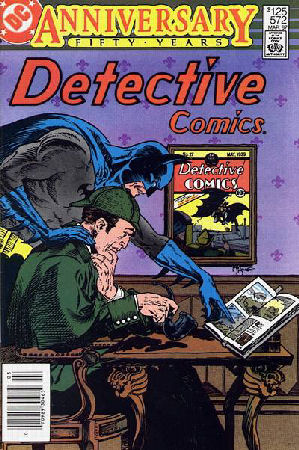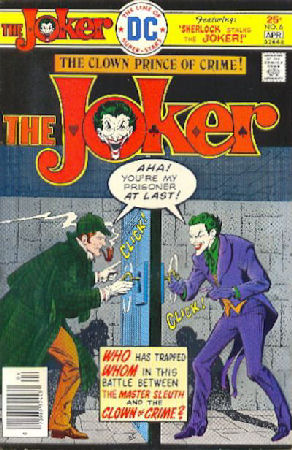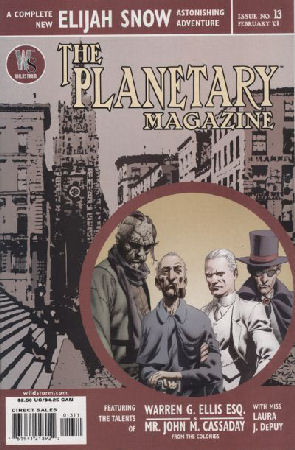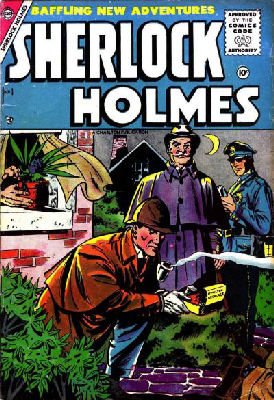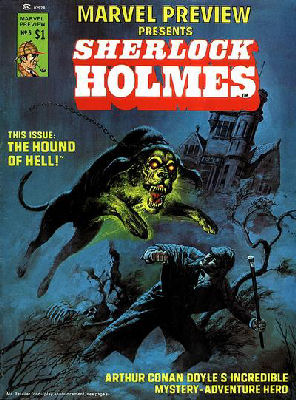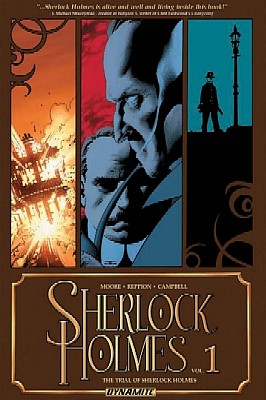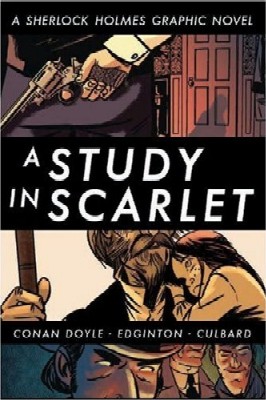Sherlock Holmes
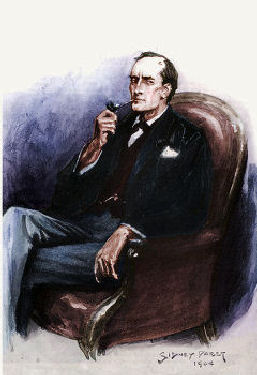 Real Name:
Sherlock Holmes
Real Name:
Sherlock Holmes
Identity/Class: Normal human
Occupation: Consulting detective
Group Membership: None
Affiliations: Dr. John Watson; Inspector G. Lestrade, Inspector Tobias Gregson, Inspector Stanley Hopkins, Inspector Bradstreet, Inspector Baynes, Mrs. Hudson (landlady), Baker Street Irregulars (Wiggins, others), Harold Stackhurst
Enemies: Professor Moriarty; Sebastian Moran, Charles Augustus Milverton, Von Bork, Count Negretto Sylvius
Known Relatives: Mycroft Holmes (brother), Vernet (grand-uncle), unidentified grandmother
Aliases: Sigerson, Altamont
Base of Operations: 221B Baker Street, London; later a cottage on the Sussex Downs
First Appearance: A Study in Scarlet (Beeton's Christmas Annual, November 1887)
Powers/Abilities: Sherlock Holmes possessed an exceptional analytical mind. His close attention to minute details combined with an intimate knowledge of a variety of esoteric subjects and substantial, if less in-depth, knowledge of an incredibly wide range of topics made him uniquely capable of solving crimes which baffled others through a combination of spotting seemingly insignificant clues, making connections others could not, and deductive reasoning.
Additionally, Holmes was an astounding physical specimen. He was strong enough to bend an iron bar with his bare hands, a skilled boxer and expert in Baritsu (a Japanese form of wrestling) and other obscure martial arts, a proficient fencer, and a capable shot with pistols and revolvers. He was a master of disguise, using both make-up and considerable acting prowess to great effect. He was an exceptional violinist.
History: In height he was rather over six feet, and so excessively
lean that he seemed to be considerably taller. His eyes were sharp and piercing,
save during those intervals of torpor to which I have alluded; and his thin,
hawk-like nose gave his whole expression an air of alertness and decision.
His chin, too, had the prominence and squareness which mark the man of
determination.
- A Study in Scarlet (1887), Sir Arthur Conan Doyle.
Sherlock Holmes came from country squire stock sometime in the mid-19th century. Both he and his elder brother Mycroft proved to have incredibly acute analytical minds; in adulthood, Mycroft went into unspecified government work, while Sherlock turned his skills to solving crime. He grew to be over six feet tall and slender, with piercing grey eyes, thin lips and a hawklike nose; though to casual observers he often seemed aloof, in truth he cared deeply for both his friends and justice. In 1881, he was searching for suitable lodgings in London, and found a suite of rooms, 221B, at Mrs. Hudson's boarding house on Baker Street; however, while he felt the rooms would be ideal for his purposes, the rent proved too high, and he looked for someone to share the costs with. Doing research at St. Bartholomew's Hospital, he happened to mention his predicament to one of the doctors, Stamford, who introduced him to Dr. John Watson, a surgeon recently returned from Army service in Afghanistan, and similarly seeking comfortable rooms at an affordable price. Stamford introduced the two men, who a day later agreed to share the apartment between them, and soon became good friends. After a short while living together, Watson learned of Holmes' chosen profession, and was invited to accompany Holmes when Scotland Yard's Inspector Gregson requested his help investigating the mysterious death of a man at the derelict house at Number 3, Lauriston Gardens, off the Brixton Road, where Holmes swiftly identified the murderer as one Jefferson Hope.
Holmes continued to solve innumerable cases, often with Watson accompanying him. Watson became his unofficial biographer, selling chronicles of Holmes' cases to papers and magazines; this annoyed Holmes somewhat, more because he felt Watson's write-ups of his work "embellished" what had happened than because he disliked having his work recorded. To Watson's disquiet, Holmes was prone to periods of depression between cases, for a time dealing with his boredom by using drugs such as cocaine and morphine (then quite legal). As his fame spread, his finances also improved; while he would charge large fees for clients who could afford them, he would also work for free if the cause was good and the client less wealthy. He purchased five other residences across London, which he used as safe houses and places to store disguises, and he sometimes used local urchins, his "Baker Street Irregulars," as his eyes and ears on the street and as messengers.
Watson eventually married, moving out of Baker Street, but still occasionally accompanying his friend when he could. However, in 1891, Holmes broke the crime ring of Britain's greatest criminal mastermind, Professor Moriarty; the "Napoleon of Crime" sent men to kill Holmes. Evading them, Holmes set in motion plans which would result in the capture of most of Moriarty's men, then asked Watson to accompany him on a trip abroad while the police apprehended the villains. However, much as Holmes had anticipated, Moriarty evaded capture, and along with his right hand man, Colonel Sebastian Moran, pursued Holmes and Watson all the way to Switzerland. Decoying Watson away from Holmes' side with a fake medical emergency, Moriarty confronted Holmes at the Reichenbach Falls, and they pair battled, until Holmes slew the villain, throwing him to his death. Aware that Moriarty had a few confederates still at large, he sought to fake his own death to give him time to locate them. He climbed up the cliff, thus ensuring that to a casual observer his footprints appeared to end at the edge, suggesting his demise, but discovered that Moran had been watching, as he tried to dislodge Holmes by dropping rocks on him. Climbing down instead, Holmes fled, leaving Watson to believe he had died and report it to the world. Holmes spent the next three years travelling the world, with only his brother Mycroft and Moran aware of his survival.
Holmes returned to London in 1894, when he revealed his survival to Watson and apprehended Moran. Over the next few years Watson and he renewed their friendship, with the now widowed doctor moving back into Baker Street for a time, and gradually helping him break his addiction to drugs. Holmes continued to solve cases through the turn of the century, eventually retiring in 1903. He moved to the South Downs in Sussex, and took up beekeeping, though he returned to his calling at least twice, once in 1907 to clear a wrongly accused local maths teacher of murder, and again in 1914. when he reunited with his old friend Watson to capture the German spy Von Bork shortly before the outbreak of the Great War.
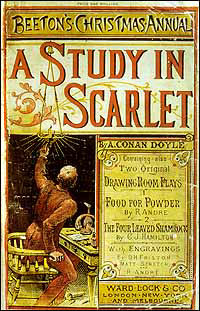 Comments:
Created by Sir Arthur Conan Doyle, who based the character in part on
Dr. Joseph Bell, his medical lecturer from Edinburgh University. Originally
intended to be called Sherringford Holmes, and partnered with "Ormond Sacker"
rather than John Watson, Sherlock Holmes debuted in A Study in Scarlet, published
in Beeton's Christmas Annual in 1887, and later as a separate novel. He returned
three years later in a second novel, The Sign of the Four, in Lippincott's
Monthly Magazine, February 1890 (later printings lost the second "the").
This was followed in 1891 by the first Holmes short story, A Scandal in Bohemia,
published in The Strand Magazine, which would be the detective's home for
several years, becoming irrevocably associated with him. In 1893 Doyle tried
to kill off Holmes, having become tired of the character, sending him over
the Reichenbach Falls in His Last Bow, but constant pressure from Holmes
fans saw Doyle relent, reviving the character in 1902 in a pre-death novel,
The Hound of the Baskervilles, and then revealing he had survived the falls
in 1903 in The Adventure of the Empty House. By the time the last Holmes
story was published in 1927, Doyle had written a total of four novels (A
Study In Scarlet, The Sign of Four, The Hound of the Baskervilles and The
Valley of Fear) and 56 short stories (collected in five volumes: The Adventures
of Sherlock Holmes, The Memoirs of Sherlock Holmes, The Return of Sherlock
Holmes, His Last Bow, and The Casebook of Sherlock Holmes). Between them,
these form what Holmes afficianados term "The Canon" (see below), separating
the Doyle penned stories from the multitude of Holmes tales produced by other
writers in the years since.
Comments:
Created by Sir Arthur Conan Doyle, who based the character in part on
Dr. Joseph Bell, his medical lecturer from Edinburgh University. Originally
intended to be called Sherringford Holmes, and partnered with "Ormond Sacker"
rather than John Watson, Sherlock Holmes debuted in A Study in Scarlet, published
in Beeton's Christmas Annual in 1887, and later as a separate novel. He returned
three years later in a second novel, The Sign of the Four, in Lippincott's
Monthly Magazine, February 1890 (later printings lost the second "the").
This was followed in 1891 by the first Holmes short story, A Scandal in Bohemia,
published in The Strand Magazine, which would be the detective's home for
several years, becoming irrevocably associated with him. In 1893 Doyle tried
to kill off Holmes, having become tired of the character, sending him over
the Reichenbach Falls in His Last Bow, but constant pressure from Holmes
fans saw Doyle relent, reviving the character in 1902 in a pre-death novel,
The Hound of the Baskervilles, and then revealing he had survived the falls
in 1903 in The Adventure of the Empty House. By the time the last Holmes
story was published in 1927, Doyle had written a total of four novels (A
Study In Scarlet, The Sign of Four, The Hound of the Baskervilles and The
Valley of Fear) and 56 short stories (collected in five volumes: The Adventures
of Sherlock Holmes, The Memoirs of Sherlock Holmes, The Return of Sherlock
Holmes, His Last Bow, and The Casebook of Sherlock Holmes). Between them,
these form what Holmes afficianados term "The Canon" (see below), separating
the Doyle penned stories from the multitude of Holmes tales produced by other
writers in the years since.
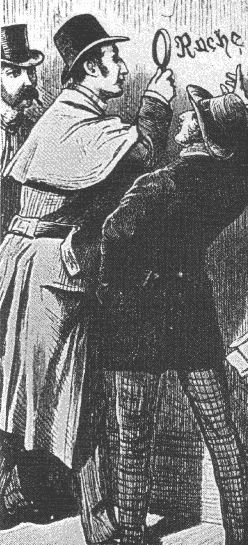 Over
the years several artists have illustrated the Holmes stories. D.H. Friston,
who produced four pictures for Beeton's Christmas Annual's original publication
of A Study in Scarlet, thus providing the world with its first visual depiction
of the character, which can be seen on the right. However, the artist who
defined Holmes and became forever associated with him was Sydney Paget, who
was hired to provide art for The Strand's publication of the short stories
which later made up The Adventures of Sherlock Holmes. Ironically Sydney
was not the man the owners of The Strand had intended to hire; they wanted
his younger and then-better known brother, Walter, but accidentally sent
the letter of commission to Sydney.
Over
the years several artists have illustrated the Holmes stories. D.H. Friston,
who produced four pictures for Beeton's Christmas Annual's original publication
of A Study in Scarlet, thus providing the world with its first visual depiction
of the character, which can be seen on the right. However, the artist who
defined Holmes and became forever associated with him was Sydney Paget, who
was hired to provide art for The Strand's publication of the short stories
which later made up The Adventures of Sherlock Holmes. Ironically Sydney
was not the man the owners of The Strand had intended to hire; they wanted
his younger and then-better known brother, Walter, but accidentally sent
the letter of commission to Sydney.
Sydney would go on to provide 537 drawings for the Holmes stories, and introduced the deerstalker hat and Inverness cape which became synonymous with the character in most people's minds, despite the fact that Holmes himself was never described in the stories as wearing either one. There are claims that Sydney based Holmes appearance on his brother Walter, but their other brother, Henry, apparently refuted this in a letter printed in the 1912 Oxford Dictionary of National Biography. Walter Paget would eventually illustrate a Holmes tale, The Adventure of The Dying Detective in 1913.
The Canon
-
A Study in Scarlet
-
The Sign of Four
-
A Scandal in Bohemia (collected as part of The Adventures of Sherlock Holmes)
-
The Red-headed League (collected as part of The Adventures of Sherlock Holmes)
-
A Case of Identity (collected as part of The Adventures of Sherlock Holmes)
-
The Boscombe Valley Mystery (collected as part of The Adventures of Sherlock Holmes)
-
The Five Orange Pips (collected as part of The Adventures of Sherlock Holmes)
-
The Man with the Twisted Lip (collected as part of The Adventures of Sherlock Holmes)
-
The Adventure of the Blue Carbuncle (collected as part of The Adventures of Sherlock Holmes)
-
The Adventure of the Speckled Band (collected as part of The Adventures of Sherlock Holmes)
-
The Adventure of the Engineer's Thumb (collected as part of The Adventures of Sherlock Holmes)
-
The Adventure of the Noble Bachelor (collected as part of The Adventures of Sherlock Holmes)
-
The Adventure of the Beryl Coronet (collected as part of The Adventures of Sherlock Holmes)
-
The Adventure of the Copper Beeches (collected as part of The Adventures of Sherlock Holmes)
-
Silver Blaze (collected as part of The Memoirs of Sherlock Holmes)
-
The Yellow Face (collected as part of The Memoirs of Sherlock Holmes)
-
The Stock-broker's Clerk (collected as part of The Memoirs of Sherlock Holmes)
-
The "Gloria Scott" (collected as part of The Memoirs of Sherlock Holmes)
-
The Musgrave Ritual (collected as part of The Memoirs of Sherlock Holmes)
-
The Reigate Puzzle (collected as part of The Memoirs of Sherlock Holmes)
-
The Crooked Man (collected as part of The Memoirs of Sherlock Holmes)
-
The Resident Patient (collected as part of The Memoirs of Sherlock Holmes)
-
The Greek Interpreter (collected as part of The Memoirs of Sherlock Holmes)
-
The Naval Treaty (collected as part of The Memoirs of Sherlock Holmes)
-
The Final Problem (collected as part of The Memoirs of Sherlock Holmes)
-
The Adventure of the Empty House (collected as part of The Return of Sherlock Holmes)
-
The Adventure of the Norwood Builder (collected as part of The Return of Sherlock Holmes)
-
The Adventure of the Dancing Men (collected as part of The Return of Sherlock Holmes)
-
The Adventure of the Solitary Cyclist (collected as part of The Return of Sherlock Holmes)
-
The Adventure of the Priory School (collected as part of The Return of Sherlock Holmes)
-
The Adventure of Black Peter (collected as part of The Return of Sherlock Holmes)
-
The Adventure of Charles Augustus Milverton (collected as part of The Return of Sherlock Holmes)
-
The Adventure of the Six Napoleons (collected as part of The Return of Sherlock Holmes)
-
The Adventure of the Three Students (collected as part of The Return of Sherlock Holmes)
-
The Adventure of the Golden Pince-Nez (collected as part of The Return of Sherlock Holmes)
-
The Adventure of the Missing Three-Quarter (collected as part of The Return of Sherlock Holmes)
-
The Adventure of the Abbey Grange (collected as part of The Return of Sherlock Holmes)
-
The Adventure of the Second Stain (collected as part of The Return of Sherlock Holmes)
-
The Hound of the Baskervilles
-
The Valley of Fear
-
The Adventure of Wisteria Lodge (collected as part of His Last Bow)
-
The Adventure of the Cardboard Box (collected as part of His Last Bow)
-
The Adventure of the Red Circle (collected as part of His Last Bow)
-
The Adventure of the Bruce-Partington Plans (collected as part of His Last Bow)
-
The Adventure of the Dying Detective (collected as part of His Last Bow)
-
The Disappearance of Lady Francis Carfax (collected as part of His Last Bow)
-
The Adventure of the Devil's Foot (collected as part of His Last Bow)
-
His Last Bow (collected as part of His Last Bow)
-
The Adventure of the Illustrious Client (collected as part of The Casebook of Sherlock Holmes)
-
The Adventure of the Blanched Soldier (collected as part of The Casebook of Sherlock Holmes)
-
The Adventure of the Mazarin Stone (collected as part of The Casebook of Sherlock Holmes)
-
The Adventure of the Three Gables (collected as part of The Casebook of Sherlock Holmes)
-
The Adventure of the Sussex Vampire (collected as part of The Casebook of Sherlock Holmes)
-
The Adventure of the Three Garridebs (collected as part of The Casebook of Sherlock Holmes)
-
The Problem of Thor Bridge (collected as part of The Casebook of Sherlock Holmes)
-
The Adventure of the Creeping Man (collected as part of The Casebook of Sherlock Holmes)
-
The Adventure of the Lion's Mane (collected as part of The Casebook of Sherlock Holmes)
-
The Adventure of the Veiled Lodger (collected as part of The Casebook of Sherlock Holmes)
-
The Adventure of Shoscombe Old Place (collected as part of The Casebook of Sherlock Holmes)
-
The Adventure of the Retired Colourman (collected as part of The Casebook of Sherlock Holmes)
Novels and short stories outside the canon
Holmes has appeared in numerous short stories and novels since Doyle's passing, and likewise inspired innumerable imitators, pastiches and parodies. He's encountered virtually every other great literary figure at some point or other, often multiple times under the pens of different authors, including Fu Manchu, Dr. Moreau, Mr.Hyde, Professor Challenger, Dracula, Griffen, Dorian Gray, Varney the Vampire, Abraham van Helsing, Raffles, Spring-Heeled Jack, Allan Quatermain, Tarzan, the Doctor, Quasimodo, the War of the Worlds' Martians, and many more; he's also caught the real-world serial killer Jack the Ripper on several occasions. The list of non-canon Holmes novels could fill an entire site, and indeed, there already exist a few good sites devoted to just this topic, so rather than reproduce all that work, here's a couple of links:
List of Sherlock Holmes novels
 Holmes on Stage
Holmes on Stage
The other visual trademark of Holmes, his curved meershaum pipe, did not originate from either the text or illustrations of the original stories. Instead it came from the stage performance of Holmes by actor and writer William Gillette, who rewrote Doyles' draft of a Holmes play, Sherlock Holmes – A Drama in Four Acts, and from 1899 toured in the role across the US and UK. Gillette would go on to perform the first Holmes broadcast, and even turn the play into a silent film, making him the first man in three mediums to portray Holmes, and his likeness was used in artist Frederic Dorr Steele's drawings of the character for American printings, thus guaranteeing that for many people, Gillette's appearance was their first exposure to the character, and other actors performing the play adopted Gillette's look as well. Gillette wore the Inverness cape and deerstalker in each performance. Wanting to have a large pipe that would be visible to the audience as well, Gillette found he could not keep his hands free by holding a regular, straight pipe in his clenched teeth, as it impeded him speaking his lines; however, the curved meershaum presented no such problem. Gillette would tour with the play on and off until 1932.
Holmes has continued to appear on stage in various productions, possibly the most notable being in 1988 in The Secret of Sherlock Holmes, a West End production in London which saw actors Jeremy Brett and Edward Hardwicke playing Holmes and Watson; both men had already become famous for their definitive depictions of the same characters in Granada Television's Sherlock Holmes series.
Film & Television
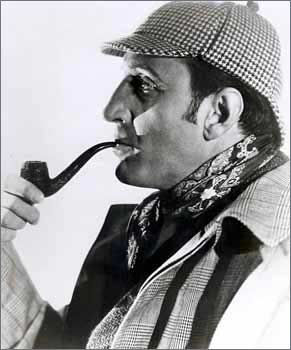 Sherlock
Holmes has probably been adapted for the screen more times than any other
fictional character, with one-off films, series, and serials made in countries
all across the world. The first known Holmes film was the 1900 short
Sherlock Holmes Baffled, coming in at under a minute in length. Further
adaptations followed, too many for me to cover them all here - again, they
could fill an entire website, so here's a good one to check out if you are
interested:
Sherlock
Holmes has probably been adapted for the screen more times than any other
fictional character, with one-off films, series, and serials made in countries
all across the world. The first known Holmes film was the 1900 short
Sherlock Holmes Baffled, coming in at under a minute in length. Further
adaptations followed, too many for me to cover them all here - again, they
could fill an entire website, so here's a good one to check out if you are
interested:
Nearly the most notable and definitive screen Holmes was Basil Rathbone; he'd still hold the title if it wasn't for the aforementioned Jeremy Brett in the 1980s. Rathbone played Holmes across 14 films between the years 1939 and 1946, beginning with Hound of the Baskervilles. After the first two films, the stories were moved from the Victorian era to the present day, allowing Holmes to battle Nazis during the Second World War.
 However,
Rathbone's crown was taken during the 1980s by the actor who remains the
screen's best Holmes, Jeremy Brett. He began his Holmesian career with the
airing of A Scandal in Bohemia on ITV on April 24th 1984, the first in a
series produced by Granada Television. As well as providing a stunning
performance as the detective, the series also maintained excellent production
values, and was truer to the stories than most of the prior adaptations in
any media, with Brett not donning the signature but inaccurate deerstalker
and Watson portrayed as he was in the books as an intelligent companion,
not the bumbling fool he had become on all too many screen adventures. Forty
one of the sixty canon Holmes tales were adapted before the series ended
in 1995 with the untimely demise of Brett from a heart attack.
However,
Rathbone's crown was taken during the 1980s by the actor who remains the
screen's best Holmes, Jeremy Brett. He began his Holmesian career with the
airing of A Scandal in Bohemia on ITV on April 24th 1984, the first in a
series produced by Granada Television. As well as providing a stunning
performance as the detective, the series also maintained excellent production
values, and was truer to the stories than most of the prior adaptations in
any media, with Brett not donning the signature but inaccurate deerstalker
and Watson portrayed as he was in the books as an intelligent companion,
not the bumbling fool he had become on all too many screen adventures. Forty
one of the sixty canon Holmes tales were adapted before the series ended
in 1995 with the untimely demise of Brett from a heart attack.
Given the sheer number of Holmes adaptations, I'm only going to touch on a handful of other performances, picked largely because each has, to me, an interesting element or twist to it that makes it stand out from the crowd.
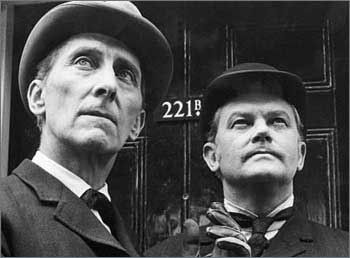 Horror
movie icon Peter Cushing played Sherlock Holmes in Hammer's 1959 feature
The Hound of the Baskervilles, the first Holmes film made in colour.
He would later return to the role in 1968 for the BBC series Sir Arthur
Conan Doyle's Sherlock Holmes, which ran for 16 episodes, and again in
1984, playing the now elderly Holmes in Channel 4's The Masks of Death,
set in 1913, with Holmes coming out of retirement to solve a case which national
security hinged upon.
Horror
movie icon Peter Cushing played Sherlock Holmes in Hammer's 1959 feature
The Hound of the Baskervilles, the first Holmes film made in colour.
He would later return to the role in 1968 for the BBC series Sir Arthur
Conan Doyle's Sherlock Holmes, which ran for 16 episodes, and again in
1984, playing the now elderly Holmes in Channel 4's The Masks of Death,
set in 1913, with Holmes coming out of retirement to solve a case which national
security hinged upon.
 1965
saw the release of Murder by Decree starring John Neville, and pitted the
great detective against the 19th century's greatest crime mystery, with Holmes
pursuing Jack the Ripper. The same basic concept, perhaps better executed,
formed the basis for 1979's Murder by Decree, with Christopher Plummer as
Holmes. In 1982 Tom Baker, who had recently left Doctor Who after
seven years in that role, tried his hand as the Baker Street sleuth in a
four part BBC mini-series adapting The Hound of the Baskervilles.
1965
saw the release of Murder by Decree starring John Neville, and pitted the
great detective against the 19th century's greatest crime mystery, with Holmes
pursuing Jack the Ripper. The same basic concept, perhaps better executed,
formed the basis for 1979's Murder by Decree, with Christopher Plummer as
Holmes. In 1982 Tom Baker, who had recently left Doctor Who after
seven years in that role, tried his hand as the Baker Street sleuth in a
four part BBC mini-series adapting The Hound of the Baskervilles.
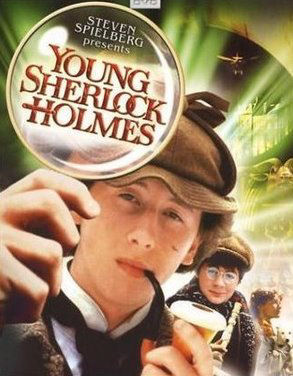 1985 saw the
Chris Columbus penned Young Sherlock Holmes, starring Nicholas Rowe
as a teenage Holmes; what could have been a disastrous mess, trying to show
Holmes' "origin" in a story which included Holmes falling in love, meeting
Watson ahead of their canonical first encounter, Egyptian cults and CGI opponents
as part of an action-adventure romp for younger viewers instead turned out
to be an enjoyable and sometimes poignant tale.
1985 saw the
Chris Columbus penned Young Sherlock Holmes, starring Nicholas Rowe
as a teenage Holmes; what could have been a disastrous mess, trying to show
Holmes' "origin" in a story which included Holmes falling in love, meeting
Watson ahead of their canonical first encounter, Egyptian cults and CGI opponents
as part of an action-adventure romp for younger viewers instead turned out
to be an enjoyable and sometimes poignant tale.
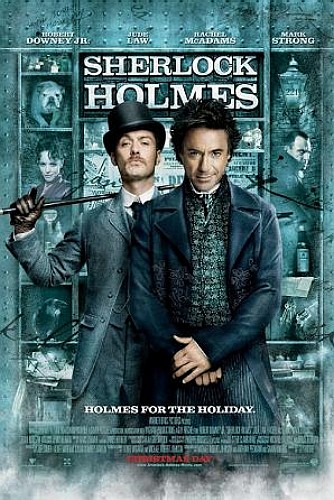 In 2009
Guy Ritchie directed a major motion picture Sherlock Holmes movie, starring
Robert Downey Jr. as a version of the detective who, while still cerebral,
was more of a two-fisted adventurer than normally depicted, alongside a similarly
feisty Watson, portrayed by Jude Law. A box-office success, a sequel was
released prior to Christmas 2011.
In 2009
Guy Ritchie directed a major motion picture Sherlock Holmes movie, starring
Robert Downey Jr. as a version of the detective who, while still cerebral,
was more of a two-fisted adventurer than normally depicted, alongside a similarly
feisty Watson, portrayed by Jude Law. A box-office success, a sequel was
released prior to Christmas 2011.
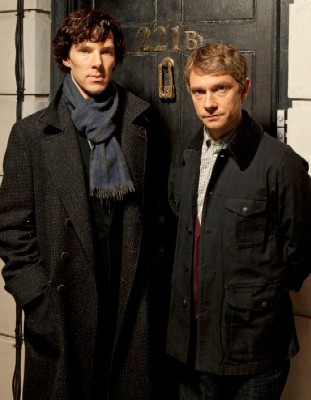 In 2010,
having been inspired by how moving Rathbone's Holmes to the then modern-day
of the 1940s had revitalised the tales, writers Steven Moffat and Mark Gatiss
reimagined the character in the modern world, with access to the internet
and texting. Starring Benedict Cumberbatch as Holmes and Martin Freeman as
Watson, six feature length adventures of Sherlock have aired to date
on BBC 1 to critical and ratings success, and another series of three more
stories have been commissioned.
In 2010,
having been inspired by how moving Rathbone's Holmes to the then modern-day
of the 1940s had revitalised the tales, writers Steven Moffat and Mark Gatiss
reimagined the character in the modern world, with access to the internet
and texting. Starring Benedict Cumberbatch as Holmes and Martin Freeman as
Watson, six feature length adventures of Sherlock have aired to date
on BBC 1 to critical and ratings success, and another series of three more
stories have been commissioned.
As well as the Holmes adaptations, on two occasions Holmes' helpers, the Baker Street Irregulars, have been the stars of their own series. 1983 saw the BBC produce 8 episodes of The Baker Street Boys, with Roger Ostime occasionally turning up as Holmes, and in 2007 the BBC released Sherlock Holmes and the Baker Street Irregulars with Jonathan Pryce as the detective. And though not Holmes in name, in 2001 the BBC's Murder Rooms showed a young Arthur Conan Doyle teaming up with Dr. Joseph Bell to solve crimes.
Comics
As with other mediums, Holmes had made numerous comic appearances, his iconic status making him irresistible for writers looking for a suitable character to team their own detective heroes with. Holmes has teamed up with the Batman, fought villains the Joker and Eclipso, was acknowledged in absentia as a teacher of both Doc Savage and the Shadow during their respective DC Comics runs, is related to Marvel Comics' Clive Reston (ally of Shang-Chi, who is tied by blood to another literary great, Fu Manchu), turned up in Planetary as part of a conspiracy of late 19th century individuals to manipulate the world into becoming a better place (alongside John Griffin, H.G. Wells, Frankenstein and his Monster, Robur the Conqueror, Carnacki the Ghost-Hunter and Dracula), and is mentioned several times in League of Extraordinary Gentlemen, where both his brother Mycroft and his foe Moriarty play large roles.
|
|
|
Holmes has never seemed able to hold down a successful series, but despite this publishers keep trying, and he has starred in numerous titles over the years. A far from complete list includes:
The first Holmes newspaper strip, illustrated by Leo O'Mealia for Bell Newspaper Syndicate. It ran between 1930 and 1932, adapting existing Holmes tales. A little over a decade later, Holmes had his first foray into comics proper, sharing one third of Gilberton's Classic Comics #21 (1944) in an adaptation of The Sign of Four; he returned to take the entirety of Classic Comics #33 (1947), which adapted A Study in Scarlet and The Hound of the Baskervilles.
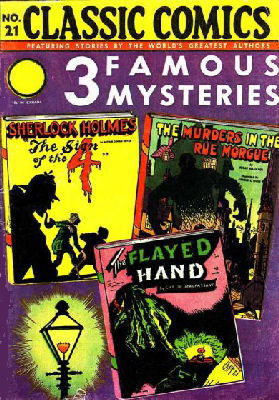 |
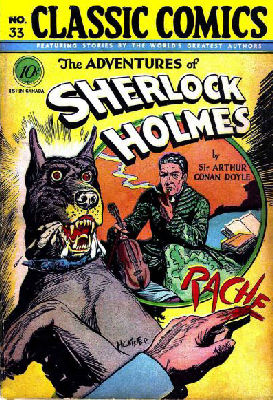 |
Between 1954 and 1956 Holmes returned to newspapers in a strip written by Edith Meisner and illustrated by Mike Sekowsky for the New York Herald. He was back in comics for Charlton's Sherlock Holmes in 1955, but only lasted two issues; Dell brought him to their Four Color Comics for #1169 (1961) and #1245 (1962), which unusually for Holmes comics at that time were new adventures and not adaptations of the Canon.
|
|
In 1975 Marvel did a two part adaptation of Hound of the Baskervilles in Marvel Preview #5 and 6; only a few months later DC gave Holmes a one-shot in 1975 (clearly planned to be a series, as it advertised the second issue which never came out), in which writer Dennis O'Neill and artist Walt Simonson adapted The Final Problem and The Empty House.
|
|
However Holmes became much more prolific in the 1980s, as his original stories approached public domain status and numerous independent publishers looked for a title with name-recognition to help establish them.
But its when his stories started to move into the public domain that Holmes really took off in comics.
Eternity Comics in the late 1980s released a 23 issue Sherlock Holmes series (reprinting the New York Herald Tribune's newspaper strip), The Sherlock Holmes Casebook #1-2 (reprinting the Dell series), Sherlock Holmes of the 30s #1-7 (reprinting the Bell Newspaper Syndicate strip), and new stories Scarlet by Gaslight #1-4 (pitting Holmes vs. Dracula), A Case of Blind Fear #1-4 (Holmes vs. the Invisible Man), and Sherlock Holmes in the Case of the Missing Martian #1-4 (Holmes vs. Jack the Ripper and H.G.Well's Martians). By all accounts, while the concepts behind these three tales were interesting, the execution and story telling wasn't.
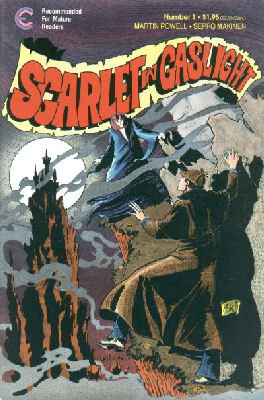 |
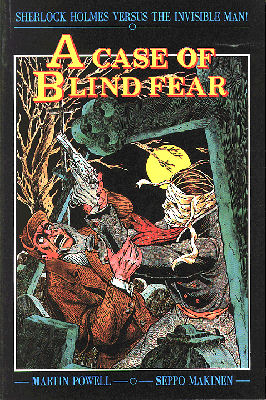 |
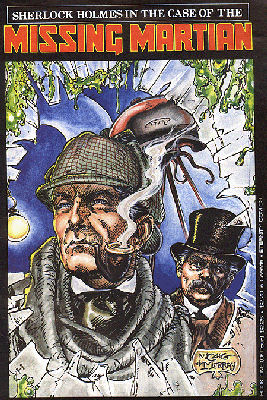 |
Renegade Press produced 15 issues of Cases of Sherlock Holmes, starting in 1985; issues #16 to 20 were then published by Northstar, who also produced one issue of Chronicles of Crime and Mystery: Sherlock Holmes, and three issues of Sherlock Holmes Tales of Mystery and Suspense in 1992 (thanks to Armida Gilbert for correcting me on how many issues of each series were published).
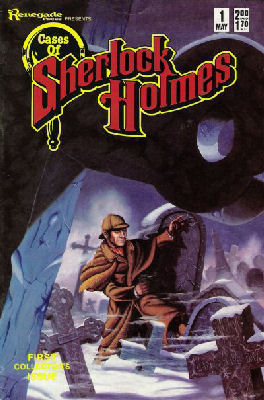 |
 |
In the early 1990s Caliber Comics published many series (sometimes via its imprints including Adventure Comics and Tome Press), including adaptations of The Adventure of the Copper Beeches, Musgrave Ritual and Naval Treaty, as well as the magazine title Sherlock Holmes Reader (mixing articles and stories), and new tales such as Sherlock Holmes: Return of the Devil in which Moriarty returned (2 part miniseries), the self-explanatory Dr. Jekyll and Mr. Holmes, and Sherlock Holmes: Adventure of the Opera Ghost where he fought the Phantom of the Opera (2 part mini-series). He also guest starred in Dracula: The Suicide Club.
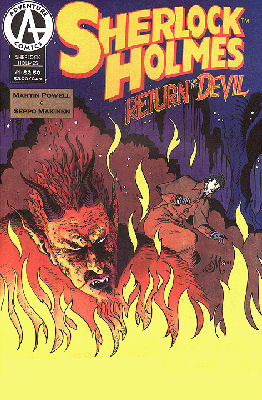 |
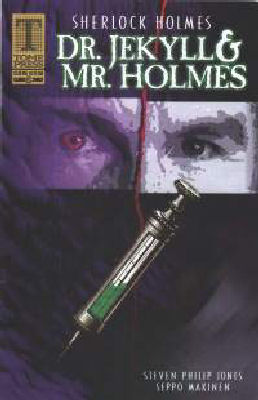 |
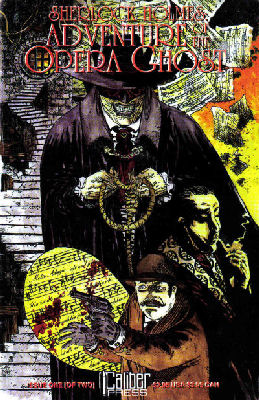 |
Since 1997 Moonstone has published new Holmes stories, including Sherlock Holmes Mysteries, Sherlock Holmes and the Clown Prince of London, as well as reprinting some of the original material from Eternity and Caliber. In 2008 the intend to release a crossover between Sherlock Holmes and Carl Kolchak, and have announced that Holmes will take part in their company wide crossover Dark Side of the Moon, alongside the Phantom, Buckaroo Banzai, Captain Action, the Cisco Kid, Airboy, Domino Lady, Kolchak, and Mandrake.
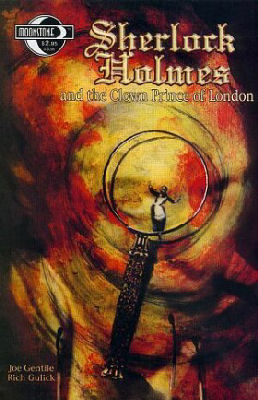 |
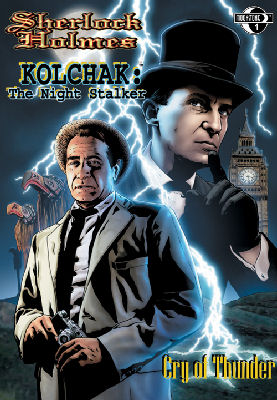 |
Dynamite Entertainment have also recently released a new Sherlock Holmes comic, written by John Reppion and Leah Moore, while Ian Edginton has written several adaptations of Holmes stories for SelfMadeHero's graphic novel line.
|
|
CLARIFICATIONS: None.
Any Additions/Corrections? Please let me know.
All images and characters depicted on this site are copyright their respective holders, and are used for informational purposes only. No infringement is intended and copyrights remain at source.
